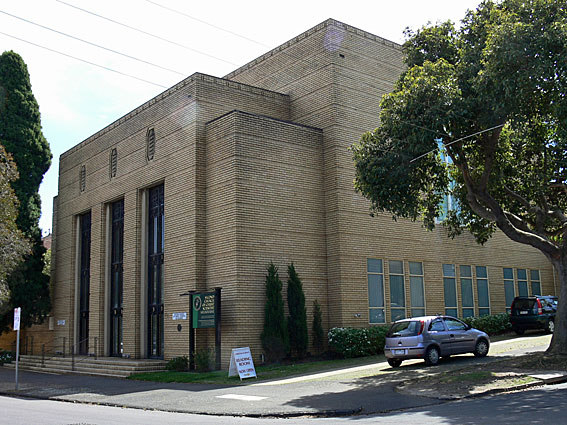
Second Church of Christ, Scientist: façade facing Cookson Street
[photograph by John Maidment (9 October 2012)]

Second Church of Christ, Scientist: façade facing Cookson Street
[photograph by John Maidment (9 October 2012)]
Historical and Technical Documentation by John Maidment
© OHTA, 2012 (last updated October 2012)
The history of the Second Church of Christ, Scientist dates back to 1924 when two Readers and initial office-bearers were elected. The first services were held in a Masonic Hall in Launder Street, Hawthorn in June 1924 and continued there until November 1936 when the Church moved to its present building, the site of which was purchased in February 1933.
In August 1934 the architects Messrs Bates, Smart & McCutcheon were appointed to design the present building, which was erected by the builders Messrs Hansen & Yuncken; the total cost was £19,660, including the pipe organ and furnishings. The foundation stone was laid on 23 July 1936 and the opening services held on 22 November of the same year.1
The building is constructed from reinforced concrete which has been externally clad in cream brick. This incorporates specially made bricks of smaller dimensions, all laid with raked out mortar joints.
One of few church buildings in the Boroondara municipality to be registered by Heritage Victoria, it is also classified by the National Trust of Australia (Victoria). It was recognised at the time of its construction as a truly modern building, looking to the future and without reference to historic styles. The Heritage Victoria statement of significance states that the building was designed in the moderne-classical manner, with 'overlapping cuboids of banded cream brickwork with patterned brick cornices, uses geometric massing to achieve a monumental form'.
The Royal Victorian Institute of Architects Street Architecture Medal for 1938 was awarded to the architects Messrs Bates, Smart & McCutcheon for the design of the Camberwell building. The award was made to encourage excellence of design in street architecture and to assist in creating a wider public interest in the work of the architectural profession. The Jury stated:
"The building which forms the subject of the award illustrates the architectural dignity which may be achieved with simplicity of massing, well proportioned voids and the judicious placing of appropriate enrichment.
"Elimination rather than decoration tends to characterise accepted standards of good architecture to-day and this building reveals a particularly happy balance between these two considerations.
"It represents a satisfactory solution to the architectural problem of a modern church without resort to traditional ecclesiastical motifs.
"The chief interest in the front elevation centres in three large vertical openings which have glazed decorative wrought iron screens, superbly designed and executed. Unity of design has been produced with cream-toned bricks and used throughout the exterior, even to the cornices and ornamental features over the doorways, the large plain surfaces being relieved with horizontal recessed bands at intervals.2
It is interesting to note that other notable churches were erected by this denomination at St Kilda Road (the First Church) designed by Bates, Peeble & Smart in 1920 and at Elsternwick (the Third Church) designed by Louis R. Williams.
The building is entered through an impressive foyer two storeys in height, via large wrought iron doors, with gilt embellishments, 24 feet in height. The foyer floors are laid with carpet in intricate patterns, reproducing the original linoleum floor tiles. The Sunday School is at ground floor level, administration at the rear, and the church itself at first floor level, lit by large windows at the east and west, and seating 450 persons. The windows have original patterns executed in sandblasted glass. The spacious and well-lit interior focusses upon the rostrum and reading desks with a large plaster grille placed as the focus and covering the organ. It is interesting that the overall style of this building appears to have been copied in the almost contemporary First Church of Christ, Scientist in Perth, WA opened in 1939.

Second Church of Christ, Scientist: interior showing the organ grille
[photograph by John Maidment (9 October 2012)]
The pipe organ is placed in a chamber behind the grille and was built in 1936 by Hill, Norman & Beard (Australia) Pty Ltd, of Clifton Hill (order number V57). It remains unaltered from the original, retaining its original stopkey console, electro-pneumatic action, sliderless windchests and pipework. It was the firm's order number V57.
The instrument is notable for the excellent quality of its voicing. The sound is bright and clear, with a very rich and stringy Viola 8 on the Swell Organ together with a Closed Horn, which sounds like a smooth Echo Tromba and a bright Harmonic Piccolo. It speaks into a fine acoustic.
| GREAT Open Diapason Claribel Dulciana Principal Harmonic Flute Swell Sub to Great Swell to Great Swell Oct to Great SWELL Viola Lieblich Gedeckt Gemshorn Piccolo 2 Closed Horn Sub Octave Unison Off Octave Tremulant PEDAL Bourdon Bass Flute Great to Pedal Swell to Pedal |
8 8 8 4 4 8 8 4 2 8 16 8 |
A A |
open wood bass CC-BB on separate chest open wood bass CC-BB on separate chest canistered metal trebles harmonic |
Compass: 61/30
3 thumb pistons to Great
3 thumb pistons to Swell
Balanced mechanical swell pedal
Electro-pneumatic action 3
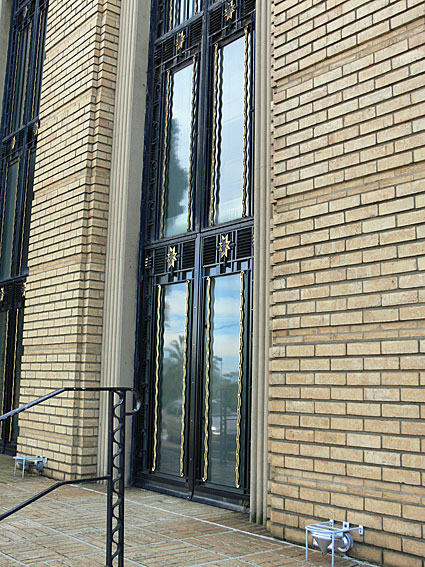
Second Church of Christ, Scientist: details of the doors facing Cookson Street
[photograph by John Maidment (9 October 2012)]
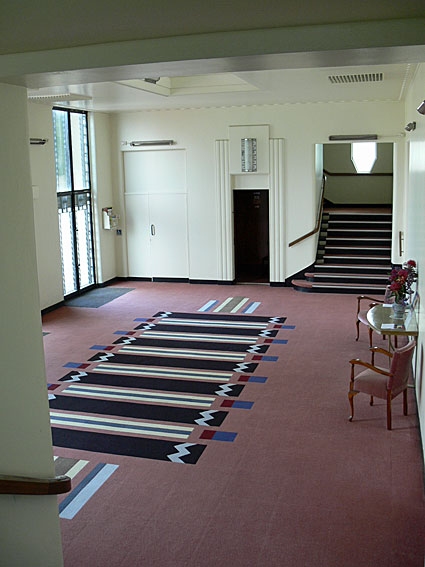
Second Church of Christ, Scientist: foyer
[photograph by John Maidment (9 October 2012)]

Second Church of Christ, Scientist: console
[photograph by John Maidment (9 October 2012)]
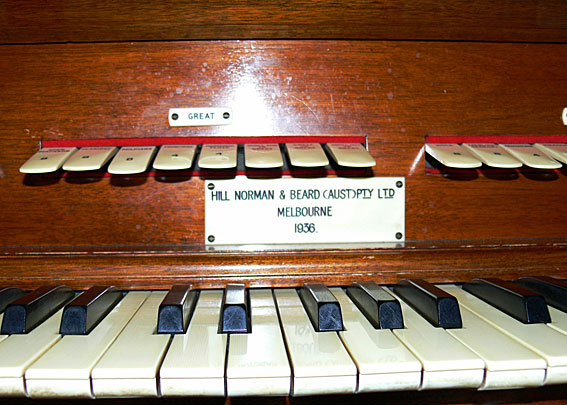
Second Church of Christ, Scientist: nameplate
[photograph by John Maidment (9 October 2012)]
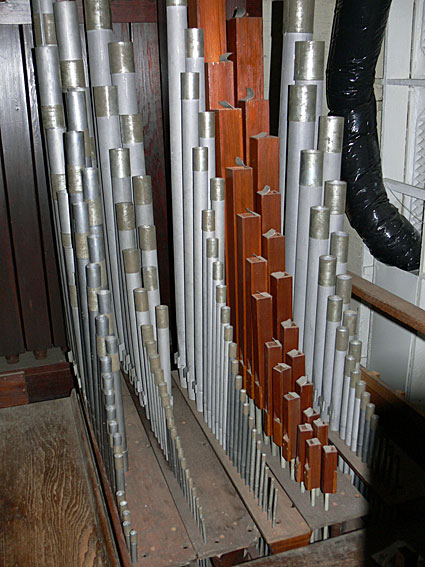
Second Church of Christ, Scientist: Great Organ pipework
[photograph by John Maidment (9 October 2012)]
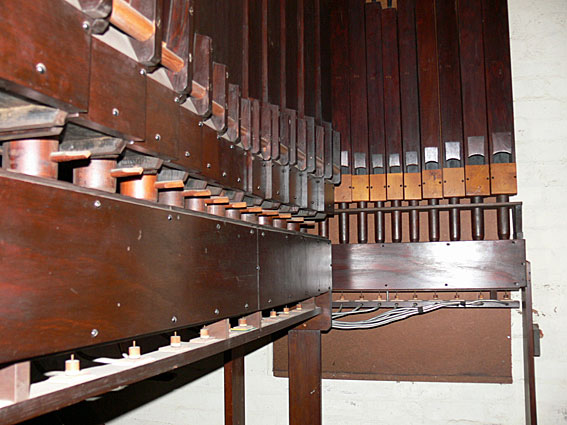
Second Church of Christ, Scientist: wooden pipework for basses of Open Diapason and Dulciana
[photograph by John Maidment (9 October 2012)]
1 Information from leaflet A Short History: Second Church of Christ, Scientist, Melbourne (n.d.) issued by the church and notes of a tour conducted by John Maidment for the Camberwell Historical Society 26 October 2012
2 Ibid.
3 Organ details noted by John Maidment 9 October 2012